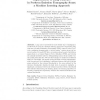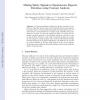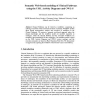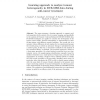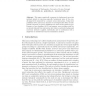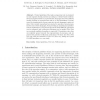124
Voted
AIME
2009
Springer
14 years 10 months ago
2009
Springer
Lung cancer represents the most deadly type of malignancy. In this work we propose a machine learning approach to segmenting lung tumours in Positron Emission Tomography (PET) scan...
109
Voted
AIME
2009
Springer
14 years 10 months ago
2009
Springer
Abstract. In pharmacovigilance, linking the adverse reactions by patients to drugs they took is a key activity typically based on the analysis of patient reports. Yet generating po...
104
Voted
AIME
2009
Springer
15 years 1 months ago
2009
Springer
Abstract. Creating computer-interpretable guidelines (CIGs) requires much effort. This effort would be leveraged by sharing CIGs with more than one implementing institution. Sharin...
115
Voted
AIME
2009
Springer
15 years 1 months ago
2009
Springer
: Clinical Pathways can be viewed as workflows, comprising an ordering of activities with associated execution constraints. Workflow models allow formal representation, analysis an...
104
Voted
AIME
2009
Springer
15 years 1 months ago
2009
Springer
Abstract The volume and complexity of knowledge produced by medical research calls for the development of technology for automated management and analysis of such knowledge. In thi...
110
Voted
AIME
2009
Springer
15 years 1 months ago
2009
Springer
Abstract. The paper proposes a learning approach to support medical researchers in the context of in-vivo cancer imaging, and specifically in the analysis of Dynamic Contrast-Enhan...
122
Voted
AIME
2009
Springer
15 years 4 months ago
2009
Springer
This paper empirically compares six background correction methods aimed at removing unspecific background noise of the overall signal level measured by a scanner across microarrays...
122
Voted
AIME
2009
Springer
15 years 4 months ago
2009
Springer
Abstract. Clinical guidelines (GLs) play an important role to standardize and organize clinical processes according to evidence-based medicine. Several computer-based GL representa...
129
click to vote
AIME
2009
Springer
15 years 4 months ago
2009
Springer
We use the concept of conditional mutual information (MI) to approach problems involving the selection of variables in the area of medical diagnosis. Computing MI requires estimate...
107
Voted
AIME
2009
Springer
15 years 4 months ago
2009
Springer
In this paper, we investigate the role of a biomedical dataset on the classification accuracy of an algorithm. We quantify the complexity of a biomedical dataset using five complex...
